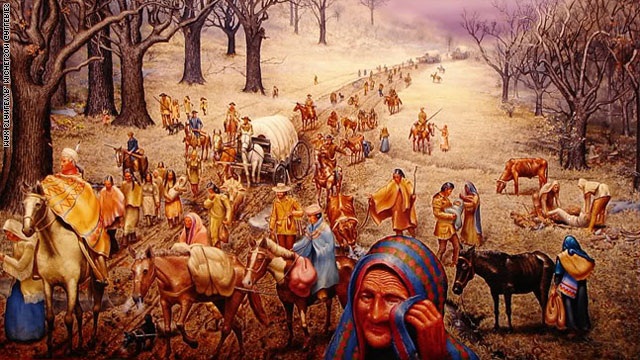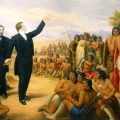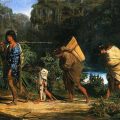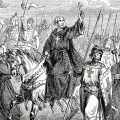By 250 years ago, it was evident that Europeans intended to stay in North America and their quest to expand their empires was nearly insatiable. European trade goods as well as the European colonists were changing the American Indian lifeways. At this time, just prior to the American Revolution, there were two major European empires in North America: the British and the Spanish.

Briefly described below are some of the American Indian events of 1768.
Indians and the European Colonists
In the Treaty of Hard Labor (negotiated at Hard Labor, South Carolina), the Cherokee agreed to some border changes. Among the Cherokee leaders to sign the treaty were Oconostota and Attakullakulla.
In Kentucky, the Shawnee did not attack the Virginians who intruded into their territory to hunt along the Kentucky and Licking rivers. Cornstalk warned colonial officials, however, that the Shawnee would not tolerate European settlements in Kentucky.
In Pennsylvania, a trader and his servant killed an Indian party of Seneca and Mohican who had become unruly. They then went to the Indian camp where they killed and scalped a woman, two girls, and an infant. The two men were arrested and brought to Philadelphia to stand trial, but they were freed by a mob who feared a precedent of Europeans being tried for killing Indians.
In Connecticut, Moor’s Indian Charity School closed. About 50 Indian students had studied at the school and 15 had returned to their homes as missionaries, schoolmasters, or assistants to non-Indian ministers. Religion professor Henry Bowden, in his book American Indians and Christian Missions: Studies in Cultural Conflict, writes:
“On the whole, however, Moor’s Charity School made no lasting evangelistic mark.”
In England, the well-known anatomist William Hunter disagreed with Benjamin Franklin and Lord Shelborn regarding the mastodon remains found at Big Bone Lick, Kentucky. He felt that the Shawnee had hunted the animal into extinction.
The Comanche War
In New Mexico, six Comanche approached Taos Pueblo under a white flag of truce. They had with them a young Spanish captive and reported that their band would be arriving soon for trade. Soon there were 400 Comanche camped at Taos.
Another band of 100 Comanche attacked Ojo Caliente but they were unexpectedly confronted by Spanish soldiers. They turned and fled, some drowning as they crossed the Rio Grande. Word of the attack soon spread to the Comanche who were camped at Taos and they also fled, killing five Spanish settlers and one Taoseño.
Three months later, a war party of 24 Comanche attacked the Spanish garrison at Ojo Caliente. The Spanish soldiers gave chase and managed to kill all but one of the warriors. From the Comanche captive the Spanish learned that there was a new Comanche leader who was acting like a “little king”. Anthropologist Thomas Kavanagh, in his book Comanche Political History: An Ethnohistorical Perspective 1708-1875, describes him this way:
“He had a guard of armed men, pages to help in mounting and dismounting, a sun shade of buffalo hide, as well as two ‘confidants’ to carry out his orders, one of whom was among those killed at Ojo Caliente.”
A month later, a group of about 500 Comanche attacked the Spanish at Ojo Caliente. The Comanche leader wore a headdress with a single green horn on his forehead and personally led the charge. The leader was killed in the attack and, from the efforts to recover his body, the Spanish assumed that this was the “little king.”
In New Mexico, the Spanish began a campaign against the Comanche using Jicarilla Apache as guides.
The Canadian Fur Trade
Regulations regarding the fur trade were relaxed and Montreal merchants were allowed to trade in the North West but not in Rupert’s Land. With the competition from the Montreal-based “padlars” Hudson’s Bay Company had a decline in trade.
In Alberta, Hudson’s Bay Company trader William Pink’s group wintered near the North Saskatchewan River. They then moved west and crossed the Red Deer River where they were caught by a prairie fire. They fought the fire by igniting a backfire. Several members of the party were burned, and four women killed.
Intertribal Relations
In New York, a delegation of Cherokee warriors met with the Iroquois at Johnson Hall. The Cherokee presented a wampum belt sent by their women to the Iroquois women. The Cherokee war chief Oconostota relayed the women’s plea for peace:
“We know that they will hear us for it is they who undergo the pains of Childbirth and produce Men. Surely therefore they must feel Mothers pains for those killed in War, and be desirous to prevent it.”
In Arkansas, the Osage captured a number of Caddo horses. The Caddo under chief Tinhiouen chased the Osage to the house of a trader. There the Caddo killed the Osage. Later, the relatives of the slain Osage were more outraged at the trader than at the Caddo and they attempted to kill him.




Leave a Reply